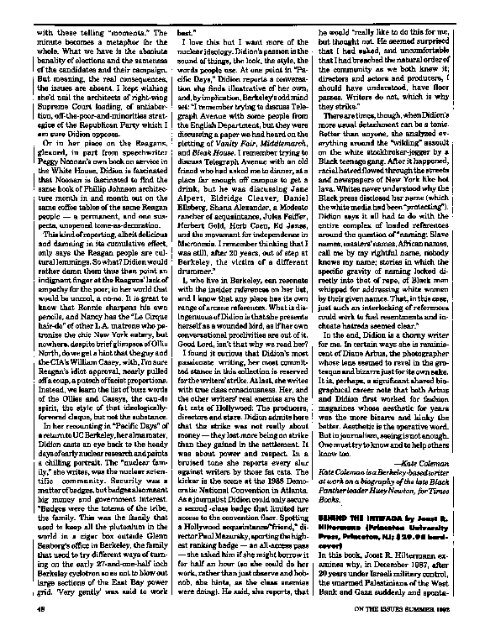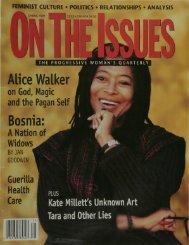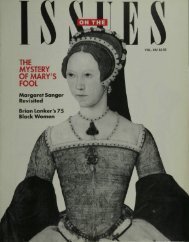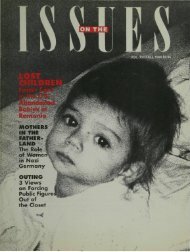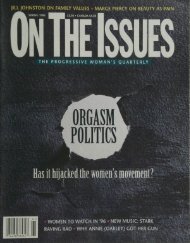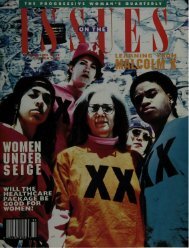300 Years & Counting 1H KILLS - On The Issues Magazine
300 Years & Counting 1H KILLS - On The Issues Magazine
300 Years & Counting 1H KILLS - On The Issues Magazine
You also want an ePaper? Increase the reach of your titles
YUMPU automatically turns print PDFs into web optimized ePapers that Google loves.
with these telling "moments." <strong>The</strong>minute becomes a metaphor for thewhole. What we have is the absolutebanality of elections and the samenessof the candidates and their campaign.But meaning, the real consequences,the issues are absent. I kept wishingshe'd nail the architects of right-wingSupreme Court loading, of antiabortion,off-the-poor-and-minorities strategiesof the Republican Party which Iam sure Didion opposes.Or in her piece on the Reagans,gleaned, in part from speechwriterPeggy Noonan's own book on service inthe White House, Didion is fascinatedthat Noonan is fascinated to find thesame book of Phillip Johnson architecturemonth in and month out on thesame coffee tables of the same Reaganpeople — a permanent, and one suspects,unopened tome-as-decoration.This kind of reporting, albeit deliciousand damning in its cumulative effect,only says the Reagan people are culturallemmings. So what? Didion wouldrather damn them thus than point anindignant finger at the Reagans' lack ofempathy for the poor; in her world thatwould be uncool, a no-no. It is great toknow that Ronnie sharpens his ownpencils, and Nancy has the "Le Cirquehair-do" of other L.A. matrons who patronizethe chic New York eatery, butnowhere, despite brief glimpses of OllieNorth, do we get a hint that the guy andthe CIA's William Casey, with, I'm sureReagan's idiot approval, nearly pulledoff a coup, a putsch of facist proportions.Instead, we learn the list of buzz wordsof the Ollies and Caseys, the can-dospirit, the style of that ideologicallyfervoredclaque, but not the substance.In her recounting in "Pacific Days" ofa return to UC Berkeley, her alma mater,Didion casts an eye back to the headydays of early nuclear research and paintsa chilling portrait. <strong>The</strong> "nuclear family,"she writes, was the nuclear scientificcommunity. Security was amatter of badges, but badges also meantbig money and government interest."Badges were the totems of the tribe,the family. This was the family thatused to keep all the plutonium in theworld in a cigar box outside GlennSeaborg's office in Berkeley, the familythat used to try different ways of turningon the early 27-and-one-half inchBerkeley cyclotron so as not to blow outlarge sections of the East Bay powergrid. 'Very gently' was said to workbest."I love this but I want more of thenuclear ideology. Didion's passion is thesound of things, the look, the style, thewords people use. At one point in "PacificDays," Didion reports a conversationshe finds illustrative of her own,and, by implication, Berkeley's odd mindset: "I remember trying to discuss TelegraphAvenue with some people fromthe English Department, but they werediscussing a paper we had heard on theplotting of Vanity Fair, Middlemarch,and Bleak House. I remember trying todiscuss Telegraph Avenue with an oldfriend who had asked me to dinner, at aplace far enough off campus to get adrink, but he was discussing JaneAlpert, Eldridge Cleaver, DanielEllsberg, Shana Alexander, a Modestorancher of acquaintance, Jules Feiffer,Herbert Gold, Herb Caen, Ed Janss,and the movement for independence inMicronesia. I remember thinking that Iwas still, after 20 years, out of step atBerkeley, the victim of a differentdrummer."I, who live in Berkeley, can resonatewith the insider references on her list,and I know that any place has its ownrange of arcane references. What is disingenuousof Didion is that she presentsherself as a wounded bird, as if her ownconversational proclivities are out of it.Good Lord, isn't that why we read her?I found it curious that Didion's mostpassionate writing, her most committedstance in this collection is reservedfor the writers' strike. At last, she writeswith true class consciousness. Her, andthe other writers' real enemies are thefat cats of Hollywood: <strong>The</strong> producers,directors and stars. Didion admits herethat the strike was not really aboutmoney — they lost more being on strikethan they gained in the settlement. Itwas about power and respect. In abruised tone she reports every sluragainst writers by those fat cats. <strong>The</strong>kicker is the scene at the 1988 DemocraticNational Convention in Atlanta.As a journalist Didion could only securea second -class badge that limited heraccess to the convention floor. Spottinga Hollywood acquaintance/"friend," directorPaul Mazursky, sporting the highestranking badge — an all-access pass— she asked him if she might borrow itfor half an hour (so she could do herwork, rather than just observe and hobnob,she hints, as the class enemieswere doing). He said, she reports, thathe would "really like to do this for me,but thought not. He seemed surprisedthat I had asked, and uncomfortablethat I had breached the natural order ofthe community as we both knew it;directors and actors and producers, Ishould have understood, have floorpasses. Writers do not, which is whythey strike."<strong>The</strong>re are times, though, when Didion'smore usual detachment can be a tonic.Better than anyone, she analyzed everythingaround the "wilding" assaulton the white stockbroker-jogger by aBlack teenage gang. After it happened,racial hatred flowed through the streetsand newspapers of New York like hotlava. Whites never understood why theBlack press disclosed her name (whichthe white media had been "protecting").Didion says it all had to do with theentire complex of loaded referencesaround the question of "naming: Slavenames, masters'names, African names,call me by my rightful name, nobodyknows my name; stories in which thespecific gravity of naming locked directlyinto that of rape, of Black menwhipped for addressing white womenby their given names. That, in this case,just such an interlocking of referencescould work to fuel resentments and inchoatehatreds seemed clear."In the end, Didion is a thorny writerfor me. In certain ways she is reminiscentof Diane Arbus, the photographerwhose lens seemed to revel in the grotesqueand bizarre just for its own sake.It is, perhaps, a significant shared biographicalcareer note that both Arbusand Didion first worked for fashionmagazines whose aesthetic for yearswas the more bizarre and kinky thebetter. Aesthetic is the operative word.But in journalism, seeing is not enough.<strong>On</strong>e must try to know and to help othersknow too.—Kate ColemanKate Coleman is a Berkeley-based writerat work on a biography of the late BlackPanther leader Huey Newton, forTimesBooks.BEHIND THE INTIFADA by Jeest R.Hiltermann (Princeton UniversityPress, Princeton, NJ; $29.95 hardcover)In this book, Joost R. Hiltermann examineswhy, in December 1987, after20 years under Israeli military control,the unarmed Palestinians of the WestBank and Gaza suddenly and sponta-48 ON THE ISSUES SUMMER 1992


